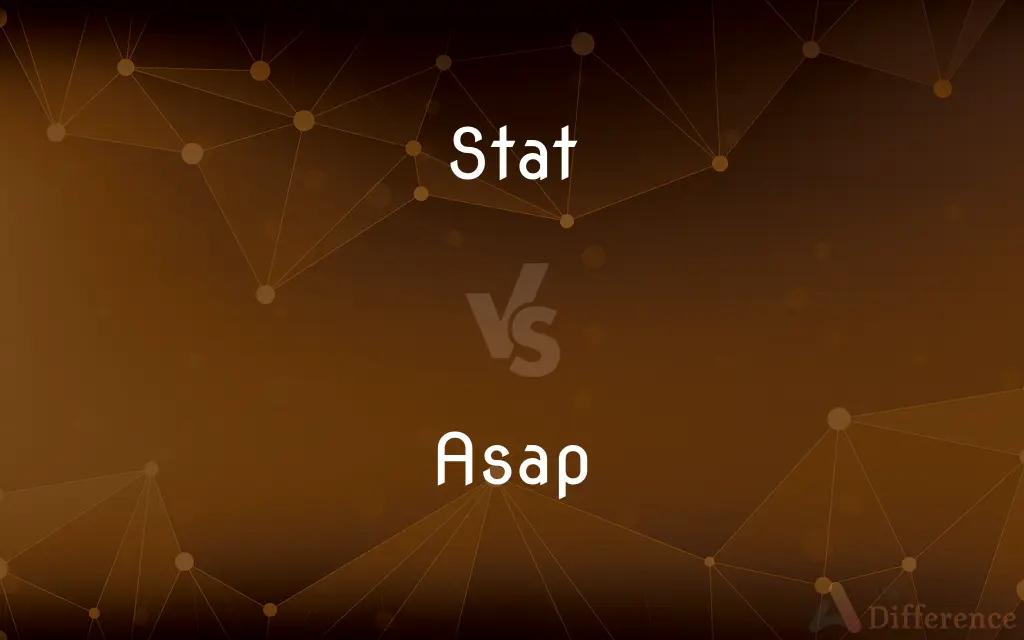STAT vs. ASAP — What's the Difference?
By Tayyaba Rehman & Urooj Arif — Updated on February 27, 2024
STAT, used in medical contexts, denotes urgency, requiring immediate action, while ASAP (As Soon As Possible) implies priority but allows for some flexibility in timing.

Difference Between STAT and ASAP
Table of Contents
ADVERTISEMENT
Key Differences
STAT, derived from the Latin "statim," means "immediately" in medical terminology. It's used to convey extreme urgency in situations where time is critical, such as life-threatening emergencies. This term signals healthcare professionals to prioritize a task above all others, with no delay. ASAP, or "As Soon As Possible," while still indicating that something needs to be addressed quickly, does not carry the same level of immediacy. It suggests that the task should be done promptly but recognizes that other tasks or priorities may also need attention before it can be completed.
When a doctor orders a test STAT, it means the results are needed at once to make immediate decisions about a patient's care. An ASAP task, although important and needing attention, allows for the completion of other tasks that are lined up before it, provided they are also being handled efficiently. It's about managing a queue of priorities rather than dropping everything.
STAT is at the top of the urgency hierarchy, leaving no room for negotiation. It is a clear directive that this task must be done now. ASAP, though urgent, falls somewhere below STAT in this hierarchy. It's urgent but negotiable based on the context of other responsibilities and tasks.
The usage of STAT is predominantly in healthcare settings, where decisions and actions can have immediate and significant impacts on patient outcomes. ASAP, however, is used in a wide range of environments, from business to casual settings, where the urgency is understood but can be weighed against other priorities.
The perception and reaction to these terms can also vary significantly. STAT commands immediate action and can heighten stress levels among healthcare professionals due to its association with critical situations. ASAP, while still signaling urgency, is less likely to induce stress of the same magnitude, given its more flexible nature.
ADVERTISEMENT
Comparison Chart
Meaning
Immediately, with no delay
As Soon As Possible, with some flexibility
Context
Primarily medical
Broad, including business and personal
Level of Urgency
Highest, no negotiation
High, but allows for some negotiation
Impact
Critical decisions, life-saving actions
Important tasks, prioritized work
Perception
Commands immediate, undivided attention
Urgent but allows for prioritization among tasks
Compare with Definitions
Stat
Used in life-threatening situations, denoting highest urgency.
The paramedics were called to the scene STAT.
Asap
Indicates urgency but allows for flexibility.
Please complete the report ASAP but prioritize the client meeting first.
Stat
Associated with critical healthcare decisions.
Order this patient's MRI STAT to diagnose the issue.
Asap
Implies prioritization among other tasks.
Finish the analysis ASAP, after current tasks.
Stat
Indicates no delay is acceptable.
The medication must be administered STAT to be effective.
Asap
Recognizes the importance of timely completion.
We need to address the feedback ASAP to improve.
Stat
Reflects a command for immediate response.
The nurse responded STAT to the doctor's urgent call.
Asap
Used in both professional and casual contexts.
I need those documents ASAP to finish the project on time.
Stat
Requires immediate action in medical emergencies.
The surgeon needed the test results STAT to proceed.
Asap
Less stressful than STAT, but still urgent.
Please reply to this email ASAP to confirm your attendance.
Stat
With no delay; at once. Used especially in medicine.
Asap
As soon as possible
Stat
(medicine) With no delay; at once.
Stat dose
Common Curiosities
Is ASAP or STAT more urgent?
STAT is more urgent than ASAP, requiring immediate action with no negotiation.
Can ASAP be used in emergencies like STAT?
ASAP implies urgency but allows for some flexibility, making it less suitable for the immediate needs of life-threatening emergencies compared to STAT.
Why is STAT used primarily in healthcare?
STAT is used in healthcare due to the critical nature of medical decisions and actions that often cannot tolerate any delay.
Does ASAP always mean something should be done right away?
ASAP means something should be done as soon as possible, but it acknowledges that there may be other priorities to manage first.
How do professionals react to STAT orders?
Professionals react to STAT orders with immediate action, understanding the critical and potentially life-saving nature of these situations.
What does STAT mean in medical terms?
In medical terms, STAT means "immediately" or "without any delay," indicating the highest level of urgency.
Can the use of STAT create stress among healthcare workers?
Yes, the use of STAT can create stress due to its association with high-stakes, urgent situations.
Is it appropriate to use ASAP for non-urgent tasks?
Using ASAP for non-urgent tasks can dilute its urgency, so it's best reserved for tasks that truly require prompt attention.
Can non-medical professionals use STAT effectively?
While non-medical professionals can use STAT to indicate urgency, its strong association with medical emergencies may not translate effectively outside healthcare contexts.
How should tasks marked as ASAP be prioritized?
Tasks marked as ASAP should be prioritized highly but can be sequenced among other urgent tasks based on overall priorities.
How does ASAP compare to other priority indicators like "urgent" or "priority"?
ASAP is generally seen as urgent but offers more flexibility than "urgent" or "priority," which might indicate a higher, but not immediate, level of importance.
How does the use of ASAP affect workflow management?
The use of ASAP can help in prioritizing tasks within a workflow, indicating that a task needs prompt attention after higher or equally important tasks.
Does the frequency of using STAT and ASAP affect their perceived urgency?
Overusing STAT or ASAP can lessen their impact and urgency, making it crucial to reserve them for truly urgent needs.
Are there specific protocols for handling STAT orders?
Yes, healthcare facilities often have specific protocols to ensure STAT orders are handled with immediate and efficient action.
Is it better to specify a deadline than say ASAP?
Specifying a deadline can provide clearer guidance on timing than ASAP, which is more ambiguous and subjective to interpretation.
Share Your Discovery

Previous Comparison
Dhokla vs. Khaman
Next Comparison
Ritual vs. RoutineAuthor Spotlight
Written by
Tayyaba RehmanTayyaba Rehman is a distinguished writer, currently serving as a primary contributor to askdifference.com. As a researcher in semantics and etymology, Tayyaba's passion for the complexity of languages and their distinctions has found a perfect home on the platform. Tayyaba delves into the intricacies of language, distinguishing between commonly confused words and phrases, thereby providing clarity for readers worldwide.
Co-written by
Urooj ArifUrooj is a skilled content writer at Ask Difference, known for her exceptional ability to simplify complex topics into engaging and informative content. With a passion for research and a flair for clear, concise writing, she consistently delivers articles that resonate with our diverse audience.














































